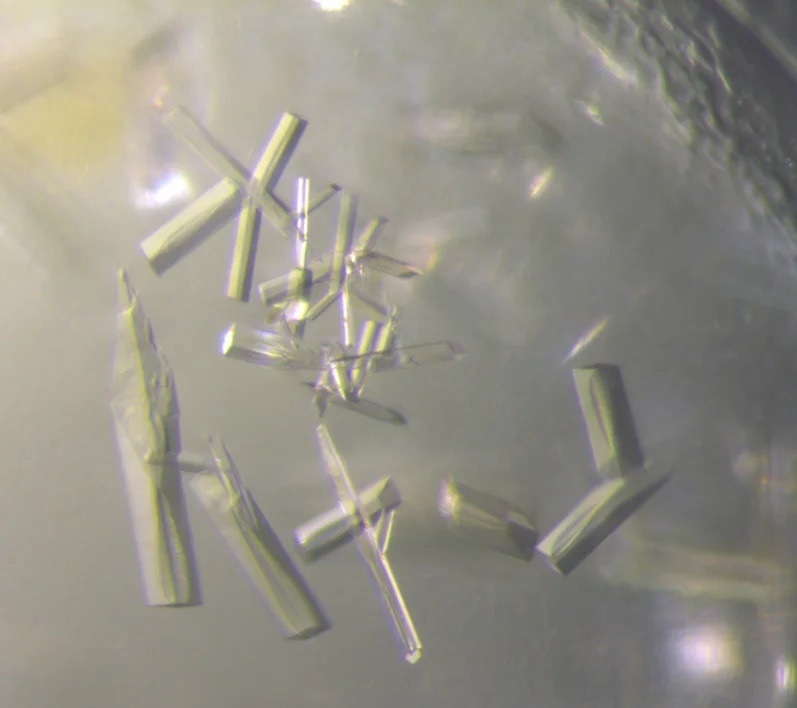Reviewed by Danielle Ellis, B.Sc.Sep 21 2022
There are billions of fungi, bacteria, and viruses, in a handful of soil, all working to support the cycle of life. Comprehending the interaction of these microbes with one another aids researchers evaluate soil carbon and nutrient cycling, soil health, and also the means through which dead insects decompose.
 Crystals of the soil virus AMG product (chitosanase) at 400x magnification. Individual crystals were cryo-cooled in liquid nitrogen before being exposed to the powerful SSRL X-rays beams for structure analysis. Image Credit: Clyde Smith/SLAC National Accelerator Laboratory.
Crystals of the soil virus AMG product (chitosanase) at 400x magnification. Individual crystals were cryo-cooled in liquid nitrogen before being exposed to the powerful SSRL X-rays beams for structure analysis. Image Credit: Clyde Smith/SLAC National Accelerator Laboratory.
Soil viruses harbor genes that seem to have metabolic functionality, however, these genes are not required for normal viral replication. These genes are known as auxiliary metabolic genes (AMGs) and they generate proteins, some of the proteins being enzymes that perform numerous functions.
Researchers were unsure if these AMG proteins perform a vital role in crucial soil processes, such as carbon cycling. Investigators analyzed the atomic structure of a protein that is expressed by a specific AMG, to discover more details about soil AMGs.
The investigators particularly irradiated fragile crystallized protein samples with high-brightness X-rays produced by the Stanford Synchrotron Radiation Lightsource’s (SSRL) Beam Line 12-2 at the Department of Energy’s (DOE) SLAC National Accelerator Laboratory. The X-rays revealed not only the molecular structures of the sample but also a little of the mystery behind their makeup.
Much like most viral genes, AMGs do not aid in viral replication. They encode different proteins, each with a distinct anticipated function. The putative enzyme AMG, which was expressed, is crucial to how soils handle and cycle carbon in the biosphere.
We saw the location of every atom in the viral protein, which helps us figure out how it functions. We were amazed to see that the protein resembles known atomic structures of related bacterial and fungal enzyme families, but also contained totally new pieces.”
Clyde Smith, Study Co-Author and Senior researcher, Stanford Synchrotron Radiation Lightsource
According to co-author Janet K. Jansson, the head scientist at the DOE’s Pacific Northwest National Laboratory (PNNL), the intricate atomic structure is unparalleled and shows for the first time the probable mechanism of this novel enzyme that may be crucial to soil ecology.
Our collaboration with SLAC has enabled us to decipher previously unknown functions carried out by soil viruses.”
Janet K. Jansson, Study Co -Author and Head Scientist, Pacific Northwest National Laboratory, Department of Energy
The study group from PNNL, SSRL, and the Joint Genome Institute (JGI) at the DOE’s Lawrence Berkeley National Laboratory, published their observations in the Nature Communications journal.
Breaking down chitin
Investigators are of the opinion that the viral AMG in the research encodes an enzyme that executes a degradation reaction on chitin. The second most plentiful carbon biopolymer after cellulose is chitin. Chitin is found in the cell wall of the majority of fungi and is a part of an insect’s exoskeleton.
The study’s viral AMG is called chitosanase protein, and sequence analysis revealed it to be a member of the glycosyl hydrolase GH75 family. This particular protein performs like a garden hoe—a tool that enables to prepare the soil for trees, vegetables, flowers, and all other forms of life—for the soil
More than 5,000 pictures collected from the crystal samples were necessary to determine the atomic structure of the chitosanase protein. By putting these photos together, it was discovered that the protein’s structural elements mirrored a recognized family of glycosyl hydrolase GH45 family enzymes that are used to break down carbohydrates.
However, the chitosanase protein contains additional molecular fragments that did not resemble those in GH45 or any other recognized protein structures, thus further research into the enzyme’s function in soil cycling is still necessary, according to Smith.
There is a part of the enzyme that is completely new and novel. That’s what’s exciting to me as a structural biologist—to see something we have not seen before, and then try to figure out what its role might be.”
Clyde Smith, Study Co-Author and Senior researcher, Stanford Synchrotron Radiation Lightsource
Further research will help comprehend why AMGs are existing, as they do not help in virus replication. Moreover, investigators can understand other AMGs present in soil viruses and their functional role in the soil ecosystem.
Smith concludes, “One of the big questions coming from this finding is, ‘What in the soil needs that carbon in the chitin. Answers to questions like this will lead to a deeper understanding about the interaction of the multitude of microorganisms in the soil, the movement of nutrients and essential molecules, and the overall health of the soil.”
Source:
Journal reference:
Wu, R., et al. (2022) Structural characterization of a soil viral auxiliary metabolic gene product—a functional chitosanase. Nature Communications. doi.org/10.1038/s41467-022-32993-8.